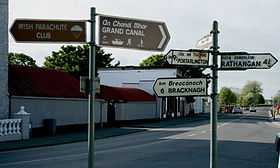Clonbollogue
| Clonbulloge Cluain Bolg | |
|---|---|
| Village | |
 Clonbulloge Location in Ireland | |
| Coordinates: 53°09′N 7°03′W / 53.15°N 7.05°WCoordinates: 53°09′N 7°03′W / 53.15°N 7.05°W | |
| Country | Ireland |
| Province | Leinster |
| County | Offaly |
| Elevation | 68 m (223 ft) |
| Population (2006) | |
| • Urban | 442 |
| Time zone | WET (UTC+0) |
| • Summer (DST) | IST (WEST) (UTC-1) |
| Irish Grid Reference | N609236 |
Clonbulloge[1] (Irish: Cluain Bolg) is a village in County Offaly, Ireland. Bolg was the Celtic sun-god and this was probably a field where followers of Bolg assembled for worship. The common pronunciation of the village up to recent times was 'Clon Bolg', which endorses this interpretation. It has been voted the tidiest town in County Offaly every year since 1978.
Location

The village is located at the junction of the R401 and R442 regional roads. The Figile River runs through the village under the R442 near its confluence with the Philipstown River.
Between the village and Edenderry, 11 km to the north, lies the Bog of Allen.
Clonbullogue is located near the point where three counties—Offaly, Laois and Kildare meet. The village is on an island of pasture land in the bog of Allen. The population of the village is 442,[2] which has remained almost unchanged for over a century.
The area is marked on the Cottonian map 1653 of Leix & Offaly as Clanbolg. In the 1659 Census, Robert Shallcross was listed as the titled person in the area. In 1679, Charles II granted this area to the Purefoy family and for a time the village was called Purefoy's Place. In 1798, the village was burned—the only part of Offaly to suffer this fate during the Rebellion. Two of the Wexford leaders, Colonel Anthony Perry and Father Mogue Kearns were captured here and were later hanged at Edenderry for their part in the 1798 Rebellion.
In 1883, Father Comerford wrote: "The village of Clonbullogue which is situated on the Little Barrow presents a decayed and ruinous appearance, some of the larger houses having been burned during the rebellion of 1798
Population
Presently, the population of the village is 980; the village population expanded in the 1950s to accommodate the many workers who were employed with the development of the bogs as an energy resource under the guidance of the Irish state company Bord Na Mona.
The village population suffered severe declines from famine, poverty and emigration from the mid-1840s. The population of the village in 1861,....... 110, 1871,........ 79
Heritage
Antiquities in the area include: the Clonkeen stone said to be 340 million years old and legend has it that the stone was thrown from Croghan Hill by Fionn MacCumhaill; remains of a togher at Ballykilleen; the ruins of Cloncrane Church; a ring-barrow at Shean and a sheela-na-gig from Ballynowlart and Clonsast. The last was an important religious site in early monastic Ireland.
People
With the conquest of Ireland from the Cromwellian wars onwards, Clonbullogue was extensively planted by colonialists.Quaker families were common under the plantations.Present day local family names can reflect these plantations.
In 1731, Rev. Boyle Travers, Protestant Rector of Rathangan and Clonmore (which includes part of this area) notes; "I bless God for the comforting assurance I have that there is no reputed friary, nunnery, friars, nuns or Popish schools".
The bigoted attitude of the ruling classes as detailed above would have common across the whole of Ireland.The lack of religious buildings and schools for the majority catholic population would have been legalized under the penal Laws.
- Eamon Broy, former Garda Commissioner, was born near Clonbullogue in 1887 and is buried in a nearby cemetery.
- Jasper Robert Joly 1819–1892, was born at Clonsast. He donated his extensive library of 23,000 printed volumes and unbound papers to the Royal Dublin Society in 1863. When the National Library was established the Joly collection formed the nucleus of the new national institution.
Clonbullogue airfield
Clonbullogue airfield is owned and operated by the Irish Parachute Club who are based at the field. The airfield has one east-west grass strip runway which is 770m long and 18m wide. There are six aircraft based on the field, most of them owned by the Irish Parachute Club. The airfield is located about 2 km (1.2 mi) west of Clonbullogue village and lies under a restricted airspace designated EI-R16. There is usually intense parachuting at weekends and public holidays.
Sport
Clonbullogue GAA club won the junior championship in the 1980s and played intermediate until 2013 when they were relegated to junior again. The club is actively involved in the underage club of St Broughans which includes their neighbours Bracknagh and Walsh Island.